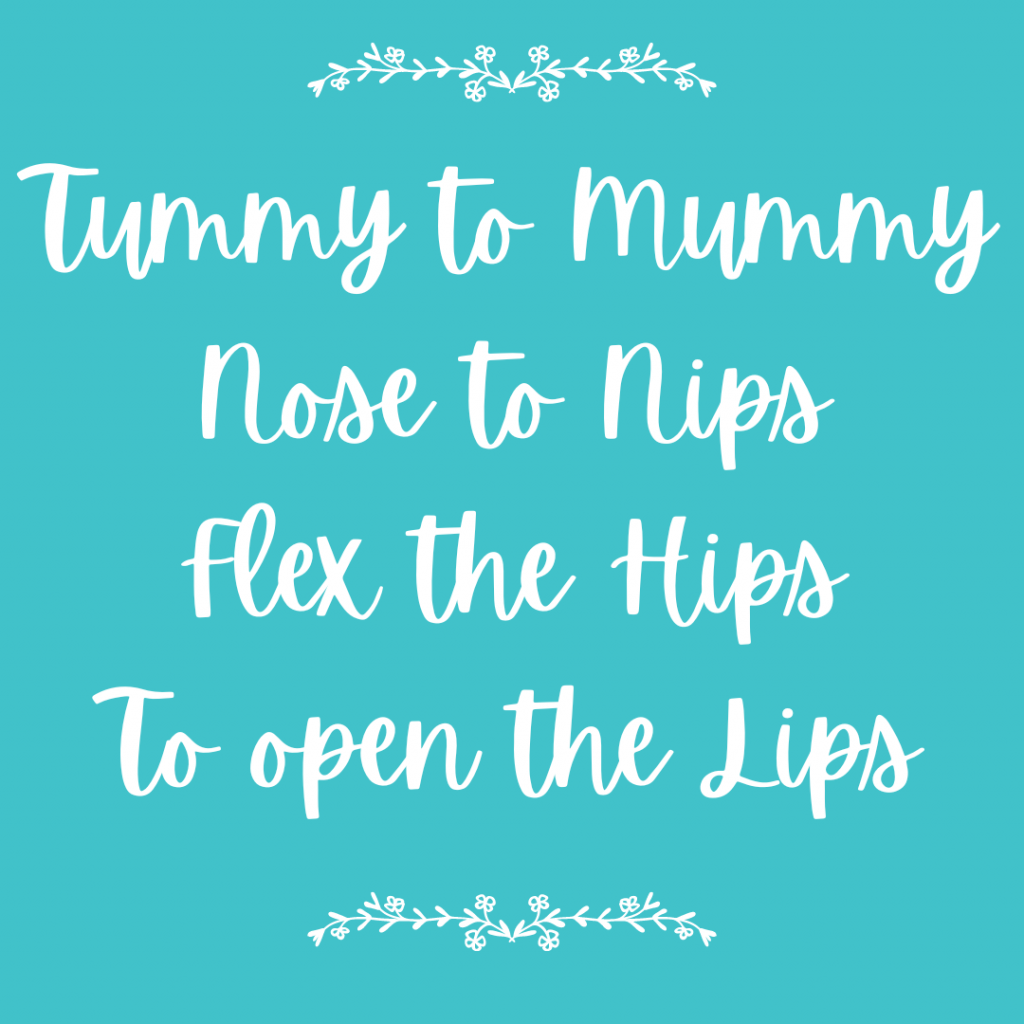On this page you will find
5 quick steps to latching
2 questions to discover if your latch is working for your baby
Answers to common breastfeeding questions

5 quick steps to latching:
(visuals provided below for extra guidance)
- When you are going to latch your baby, hold them close, their stomach against your stomach. Flex their hips by gently supporting their bottom. Your baby needs to smell your nipple to understand where their food source is, so be sure their nose is at your nipple. In most cases, the infant will begin to move their head around instinctively and open their mouth to find their food source.
- After their nose has been close to your nipple, move them away a little so you can see their mouth opening up. Because of their lack of muscle control, you will need to be a guide for their head. Help their head tilt back naturally to allow them to get your nipple into their mouth. This will feel like more neck support than the back of the head support. You want their head to be able to move a bit so they can develop the skills needed to do this on their own.
- When their mouth is open wide, bring your baby closer to you and aim your nipple toward the top of their mouth.
- Once the baby is attached to you, they will begin to interact with your tissue to get what they need. You should be able to watch their face for signs of discomfort and trouble. And, of course, watch their face for that connection time when they learn more about your smells, sounds, and what you look like as their eyes learn to focus.
- Help the baby sustain this seal by keeping their chin against the breast. An asymmetrical latch is best, so you will most likely see more areola showing by their nose than their chin. Make sure they are able to breathe through their nose. Remember that in the early days, they have very little control over the neck muscles needed to control the head. This means they rely on you to help them enter a position of comfort and sustained suction contact. Their neck should be supported, and the head should be able to move around as they “root” and interact with the tissue. This is a sort of dance in the early days and you are helping them stay on their food but also helping them to learn how to control their motor functions specifically geared around this relationship with your breastmilk. Just like their heads need some movement, so too do their arms and hands. Allow their arms to embrace your breast. You want your infant to interact with their breastfeeding experience so they can help you help them as they grow.
TLDR: To latch a baby for breastfeeding, ensure the baby’s nose is at the nipple, guide their head as they open their mouth, insert the nipple toward the top of their mouth, watch for signs of discomfort, and help sustain the seal by keeping their chin against the breast. This process helps the baby learn about their food source and develop motor functions.
Answer these 2 quick questions to help determine if your latching process is working for you.
- Is your infant staying on your breast suckling contently? If yes, you have probably latched perfectly fine.
- Is there a milky substance appearing around your infant’s mouth at times, but it does not drip out and away from their mouth? If yes, you probably have a great latch.

Learn More
- Pain
- Sounds
Breastfeeding should not be painful.
If you are feeling sharp pain, pinching, creasing, soreness, cracking, blistering, or misshapen nipples after you feed PLEASE contact us so we can help! While there may be some unavoidable discomforts in this breastfeeding journey, many of the items listed above have available solutions.
Breastfeeding should not sound like clicking.
If you are hearing your infant’s tongue doing a lot of work, the clicking noises could be because they are sucking in the air and having trouble latching. We can help with this, too.
There are many breastfeeding positions to choose from.
If you find difficulty with one position try another! There are many to choose from. Women with larger breasts may find the Football Hold beneficial while someone with a larger milk supply or powerful letdown may find the Reclining or Laid-Back position helpful. Our office is happy to chat with you about different breastfeeding positions.
It is an honor to support you in this journey. Please do not hesitate to call us with questions about the information we are providing.

